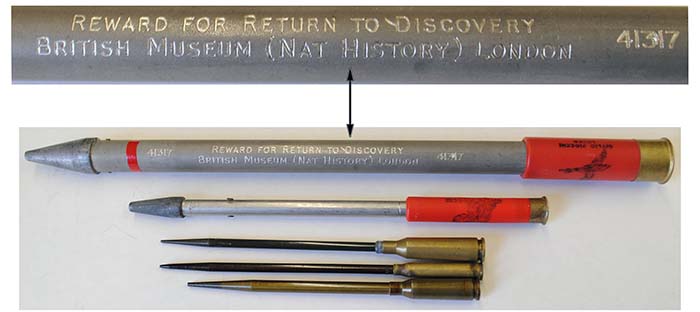By Richard MacLean
The holy grail of any gun library is an autographed five-volume set of The Machine Gun, by Col. George Chinn, United States Navy Department Bureau of Ordnance. On the inside back cover of Volume 5 are photographs of small arms legends such as Eugene Stoner and William Ruger next to one of William H. Woodin. The reaction of most readers might be, “Woodin who?,” but to forensic scientists, ammunition collectors, small arms authors, researchers, and inventors around the world, it is a name that ranks right up there with other industry notables.
This article is about Woodin Laboratory, described by Pepper Burruss, president of the International Ammunition Association (IAA), as “the international center for the study of post-1880 military and police ammunition under 35mm. It traces the entire evolution of modern small arms ammunition. No other collection, government or private, comes close. It contains many thousands of specimens, scores of which are the only known examples in existence.”
Woodin Laboratory was built in 1973 near Tucson, Arizona, and is a private operating foundation, qualifying under section 501(c)(3) of the Internal Revenue Code. As such, it is an educational institute and contributions to it are tax deductible. The 3,000 square foot windowless, partially underground vault is constructed entirely of masonry block and reinforced concrete slabs. The structure is equipped with appropriate fire safety and security devices and is ideally suited for cartridge storage.
The floor space is sub-divided into the main research area, inventory storage rooms, a photo and X-ray lab, and offices. There is an extensive library of reference material. Walls not lined with cartridge storage cases or bookcases are covered with cartridge display boards. This collection of boards, many of which are contained in the rows of storage cases, represents probably the largest board collection in the world of military and police ammunition. The Lab obtains these boards not just because they are interesting to examine but because they sometimes contain the only remaining samples of specific cartridges.
Besides Mr. Woodin, the lab depends on volunteer workers; regulars are Norman D. Hower, a Lab Director, and A. Donald Amesbury, founder of what is now the IAA. Additional support staff and workers come from out of state or even other countries.
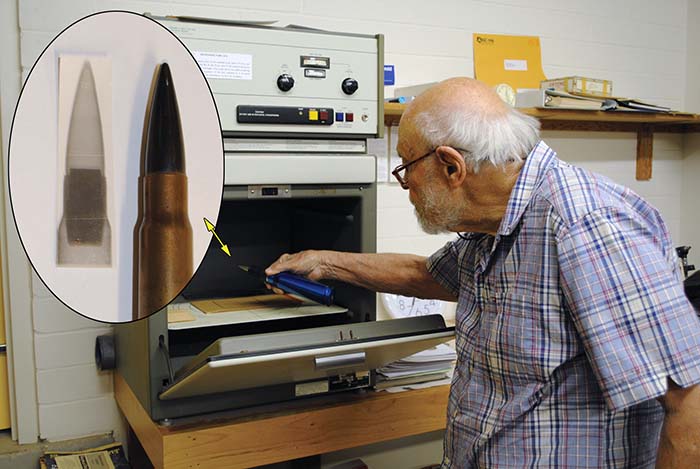
There are a total of nine Lab Directors and altogether they have written and published scores of articles in the various cartridge journals around the world. For example, Frank W. Hackley (Col., USA, Ret, and past Commanding Officer of both the Lake City Army Ammunition Plant and Frankford Arsenal), Bill Woodin and illustrator Eugene L. Scranton have written two volumes on the history of modern U.S. military small arms ammunition. The third in the series covering the period 1946 – 1977, is nearing completion.
This article is also about the man behind the Lab, Bill Woodin. Few know of him outside the ammunition and forensic communities because he is an extremely private and modest individual. Indeed, Small Arms Review is privileged to publish the first ever in-depth interview and description of the Lab.
Bill never discusses his professional honors but with some research and prodding we are able to provide a few examples here. He is Technical Advisor to and Distinguished Life Member of AFTE (Association of Firearm and Tool Mark Examiners), Past President and Fellow of the Arizona (now Arizona-Nevada) Academy of Science, Fellow of the American Association for the Advancement of Science, Life Member of the National Defense Industrial Association, and a former Consultant to the U. S. Army Armament Research and Development Command (Armament Concepts Office). His grandfather was Secretary of the Treasury under Franklin D. Roosevelt and was in the thick of the battles over taking the U.S. off the gold standard and creating the forerunner of the FDIC (Federal Deposit Insurance Corporation) during the Depression. Bill is one of the original founders of what became the IAA and has remained an active contributor to its publications and bi-monthly journal over the last 55 years.
The Early Days
SAR: What got you started in cartridge collecting?
Woodin: I think I must have some sort of gene for collecting. My first interest was collecting snakes during the early years in Arizona – where we had moved for my father’s health – starting in 1930 at the age of four.
After my parents divorced, my mother later married Melville H. Haskell who was a horse breeder and a founder of the American Quarter Horse Association. He was a shooter and was interested in guns. He introduced me to shooting at an early age and instilled in me a real respect for guns and gun safety – to this day I get the creeps when someone points anything at me, even a finger. He also supported me in my growing interest in ammunition and we would go around to gun stores and try to talk them into selling single cartridges. This only seemed to work if there were partial boxes.
I also spent a lot of time out and about looking for snakes and arrowheads on the ranch and fortunately, since I’m still alive today, my mother would not allow me to collect poisonous snakes. That came later. (Laughs).
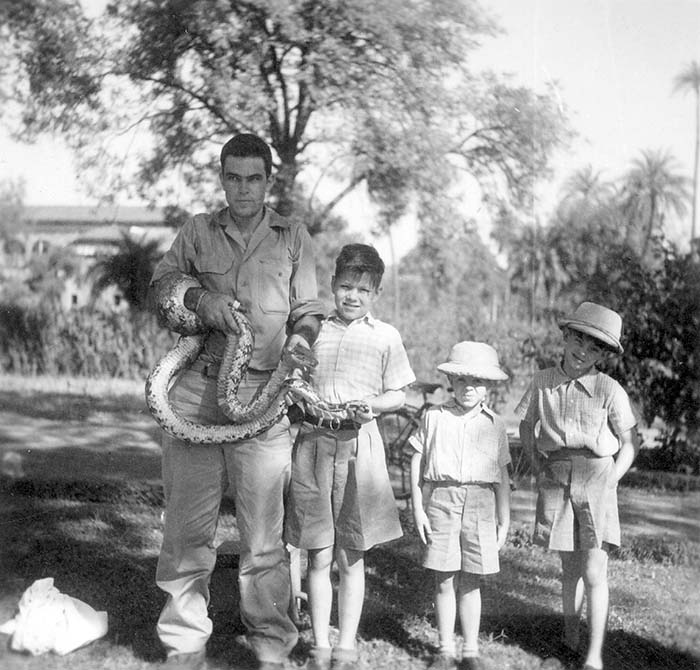
Snakes were a primary interest back then and this led to a degree in zoology at the University of Arizona and later a graduate degree in zoology at the University of California – Berkeley. My specialty at Berkeley was herpetology (the study of reptiles and amphibians). I suppose I must have been born with the same collector gene as J Curtis Earl, the famous Class 3 gun dealer. He started collecting arrowheads on his parents’ farm, majored in wildlife biology, raised turtles, lived in Arizona, and collected guns. I knew him and once testified in his defense at a trial where they needed someone who knew something about cannon ammunition.
SAR: Was it your involvement in WWII that got you interested specifically in military and police cartridges?
Woodin: Actually, I was interested in this field long before then. I joined the American Field Service, which operated in all the theaters, and provided ambulance drivers for the British army. Technically I was a civilian and I drove a jeep ambulance shuttling wounded soldiers from the front lines, where they received first aid to stabilize their wounds, back to the field hospitals. I requested that I be sent to India and Burma because that is where the best snakes are. (Everyone laughs) No, I’m not kidding. I had two Indian pythons and a cobra, among others, at various times.
I was first stationed in Imphal in northeast India, arriving after the great battle of Kohima, which halted the Japanese invasion of India, and was attached to a Punjab battalion of the Indian army. The ammunition dump at Imphal was a treasure trove, especially since I was interested in artillery ammunition at the time. After deactivating whatever ones I could, I would mail them home to my mother, who was a good sport about this. So was the mailman who lugged armfuls to her front door. My mother told me that one time a heavy package had disintegrated and he wrapped his belt around the shells to lug them up the driveway to the house.
I also collected some guns, trading a carton of cigarettes for a Japanese Type 96 light machine gun which had just been captured by a tank crew. Back then you could bring back such weapons with the proper paperwork and get them registered under the non-willful violation clause. Another time I came upon a bank in Burma that had just been liberated, and there were stacks of new Japanese occupation currency. That got me off on another collecting diversion. I also got interested in edged weapons. And after I found a very unusual Japanese hand grenade in a village we had just captured, I deactivated it and started collecting other grenades.
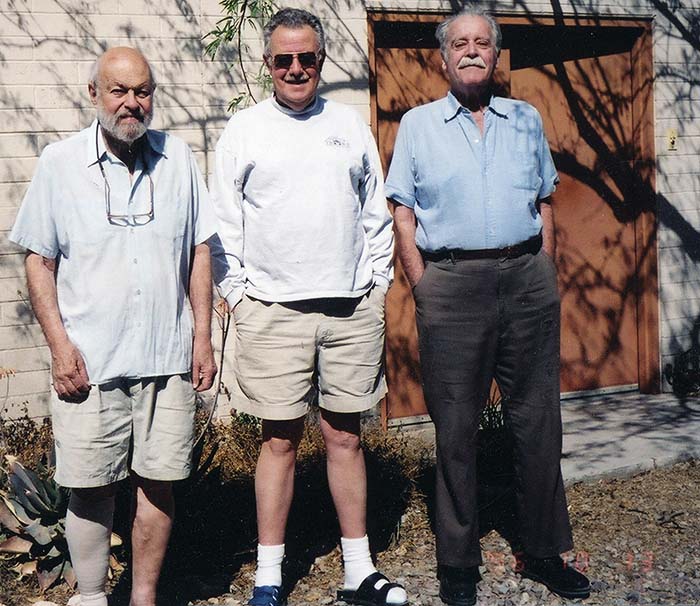
I decided that if I was going to do any significant research in this field, I had better define my parameters. I decided to stay under 37mm since there are numerous 37mm variants, used by a multitude of countries. Indeed, there have been so many over the years that a specialist in this field, Robert Mellichamp, is currently writing a multi-volume set on just this one caliber. Later, when Oerlikon developed its famous 35mm antiaircraft system, I decided that was a good caliber to stay under also.
SAR: When did it change from a hobby to a serious research endeavor?
Woodin: After the war I really got serious in expanding my collection and studying the development of military and police ammunition. Interest in cartridges was growing, and in 1955 the Cartridge Collector’s Club was formed. In 1961 this club joined with the slightly younger National Cartridge Collectors Association and became the International Cartridge Collectors Association (ICCA). In 1993 it became the International Ammunition Association (IAA). The European association was founded in 1964 as ECCC, later ECRA, European Cartridge Research Association. And a number other countries, such as Australia, Czech Republic, Slovakia, New Zealand and South Africa, have their own active associations. Also several states have their own groups.
I was not interested in sporting or commercial ammunition, just this narrower field. It is impossible to be knowledgeable about or have an extensive collection in every area since the possibilities are enormous. Serious collectors target one or a few cartridge types or related areas such as belts, clips, chargers, powder cans, storage boxes and so on. For example, as large as the Lab is, it still represents only a small sampling of the military and police cartridges that have been made since 1880. People who have seen the Lab may find this difficult to grasp.
SAR: Were you buying or trading or both to build the collection?
Woodin: Both. I was running ads in the 1950s offering to buy cartridges that I did not have in my field of interest. At the same time, I was also building my trading inventory. (Pepper Burruss states, “The Lab’s trading inventory alone is far larger than the collections of most IAA members.”)

A trading inventory is essential, since many serious collectors are reluctant to sell rare cartridges, but they will gladly trade a duplicate sample from their own inventories for another that they do not have. There are probably at least 10,000 serious collectors in the world and, of course, supply and demand sets the price. Rare and one-of-a-kind examples can bring as much as $1,000 or more.
After finishing my graduate work at the University of California I was able to land a job at the newly-formed Arizona-Sonora Desert Museum outside of Tucson and became Director from 1954 to 1971. It is a combination zoo, museum, geology exhibit and botanical garden, all focused on interpreting the Sonoran Desert region. It was the perfect environment for me.
Awareness of the collection spreads
SAR: How did the word spread about your collection and your expertise?
Woodin: The ads contributed, of course, and I was also writing for the newsletters and journals of the various collector organizations. I generally write about cartridge areas where little or nothing has been written previously. Information on the older cartridges is often not easily available because the factory records have been destroyed. I use patents, historical archives, old books, a network of experts, interviews with industry personnel, and, of course, samples from the Lab and other collectors.
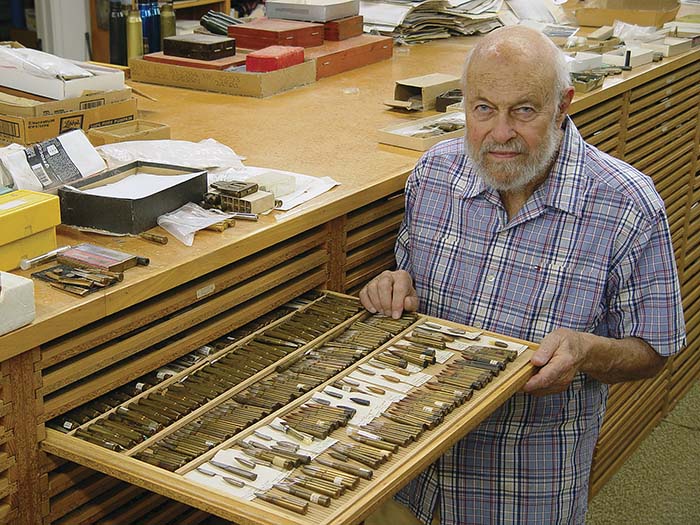
I suppose word of mouth was also a major factor in getting the word around. In addition, there was a real need among forensic laboratories for information or samples. For this reason I was accepted by AFTE (Association of Firearm and Toolmark Examiners) in 1975. As the word spread, I started getting more and more calls. For example, after the Kennedy assassination I received a call from the House Select Committee on Assassinations which wanted samples of the identical cartridges that were used in that 6.5 mm Carcano rifle. And they wanted them NOW! Many people assumed that he was shot with Italian war surplus ammunition. In fact, it was contract ammunition made by Western Cartridge Company in the U.S. in 1954, with a WCC headstamp.
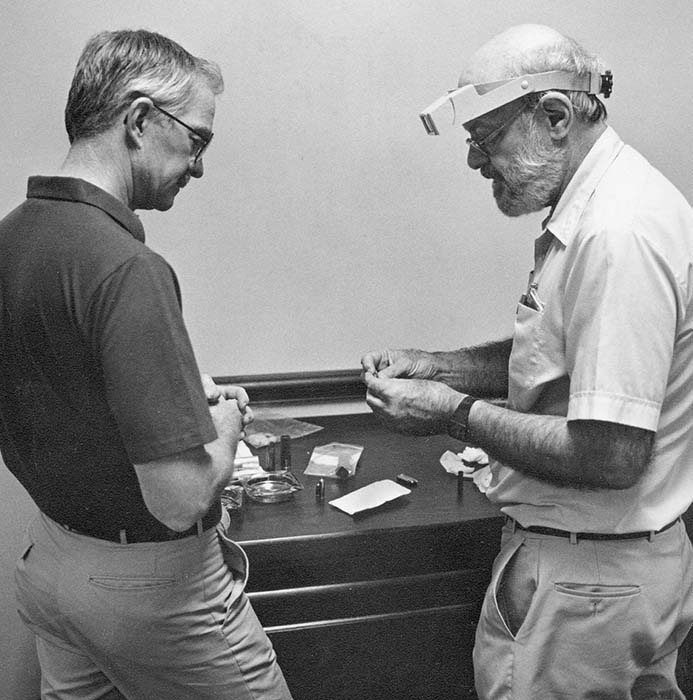
Another interesting example was research on a rifle cartridge that no one seemed to be able to identify the rifle it was used in. It was a cartridge in search of a gun. Then, Herbert Woodend of the British Ministry of Defense Pattern Room, told me they had received a rare Chinese version of the 8mm Austrian Model 1888-90 Mannlicher and supplied us with a chamber cast. Sure enough, it matched perfectly. Since the cartridge itself didn’t have a name (just being identified by the rifle) I named it 7.62 x 55R and wrote an IAA Journal article about it. It is like discovering a star: you get naming rights.
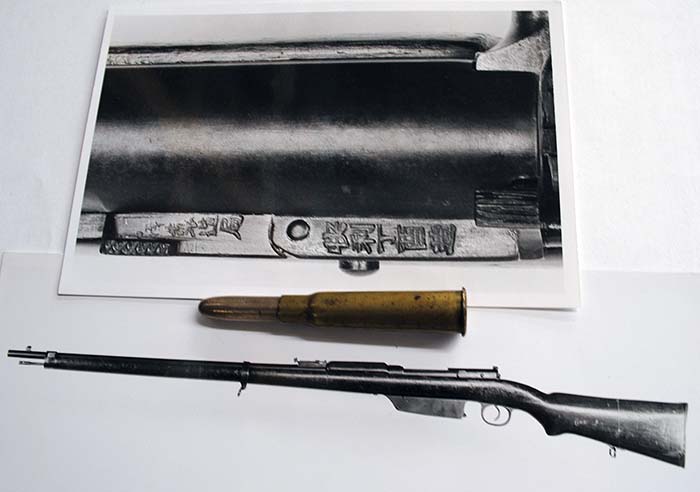
Yet another example was when George Chinn called and said he needed help with some cartridge photos. I assumed he was sending me a list of cartridges. Instead he sent me a list of weapons and I had to figure out the correct cartridge for each. For me, these investigations and links to history are what make cartridge research so much fun.
SAR: Why did you decide to build the Lab?
Woodin: My collection finally reached the point where I needed more space. On top of that, inquiries were coming in at such a rate that a dedicated facility was needed to properly respond. So after I retired from the Desert Museum in 1971, and had the time, I built the Lab.
SAR: How do you keep track of all these cartridges?
Woodin: The Lab started well before the age of computers, so we set up a card file system. The only cartridges we formally catalog are those that have box labels or other special information that would not otherwise be known. Only about ten percent are cataloged in this way. All are stored by caliber in specially-made drawers, starting with the country of origin, then alphabetically by country, with an unidentified section at the end. The library is chiefly indexed by country, and there is also a section containing general information, including foreign language and other special dictionaries which are so important to the cartridge researcher.
Cartridge development
SAR: Who in the past did R&D on military and police cartridges? What about today?
Woodin: In the U.S., Frankford Arsenal did much of the military experimental work, which became dispersed after its closure in 1977. Important work was done in Europe in the late nineteenth century, for example by the Swiss pioneer Eduard Rubin who developed the small-caliber jacketed bullet, and Friedrich Hebler who designed rifle calibers as small as 5mm. Hebler also worked on tubular bullet designs, developed further in modern times by the prolific U.S. inventor, the late Abraham Flatau. A very imaginative and prolific modern-day experimenter was the German Hans-Ludwig Scherniker.
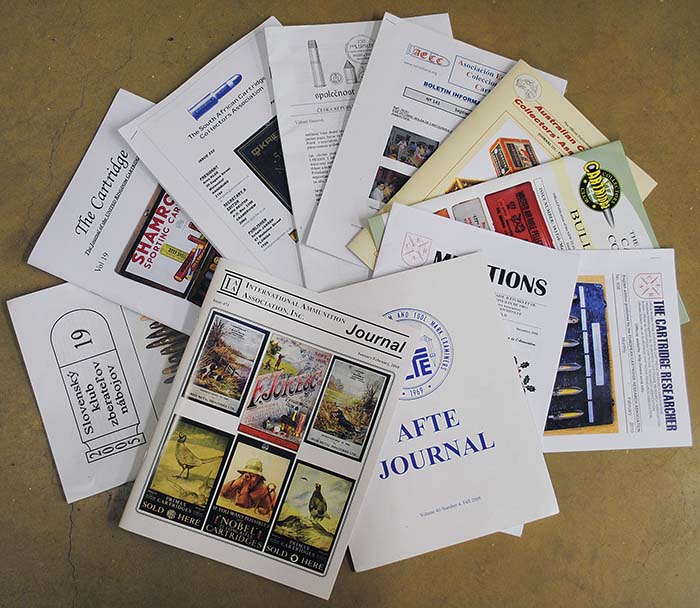
Alternative case materials were also developed early. For example, Frankford Arsenal made .30-40 Krag aluminum cases in 1895; the German firm Polte, Magdeburg made aluminum cased 8mm M88 ammunition with steel heads in 1893; Austria made 8x50R aluminum cases and celluloid cases with aluminum heads prior to World War I; and steel was used very early, titanium alloys were tried, and so forth.
Military arsenals, of course, and large companies such as Bofors and Oerlikon are experimenting in this field today. There have also been a number of private individuals – outstanding examples would be the late Maxwell Atchisson and Gordon Ingram – and smaller companies in this country, such as Engel Ballistic Research, Silver State Armory, SSK Industries, and many others. We would like to do a better job of keeping track of all of these R&D efforts and obtain samples of their work.
SAR: What have been some of the milestones along the way and some of the more interesting cartridges?
Woodin: The transition from black powder to smokeless was of course extremely important. I have always been intrigued by the taper-bore experiments of Hermann Gerlich and Frantisek Janecek in which the diameter of the bullet was reduced before exiting the barrel. Russell Robinson designed a similar type, the Salvo Squeezebore, which squeezed and separated multiple bullets. Other interesting innovations have been directed at shortening the length of the cartridge by having the powder alongside instead of behind the bullet. Frankford Arsenal accomplished this with their “folded” cartridge and Hughes with their “chicklet” and lockless system.
Caseless ammunition is another interesting type, nearly adopted by Germany in their G-11 rifle, and there are still ongoing attempts to perfect that design. There have been the unusual rocket cartridges such as the MBA Gyrojet as well as electronic ignition systems. During WW2, the Hungarian engineer Bela Zettl developed a multi-bullet cartridge which the Luftwaffe nearly adopted as the H.F. 15, with a cyclic rate of 36,000 rpm. The U.S. was also sufficiently intrigued by this design to experiment with it.
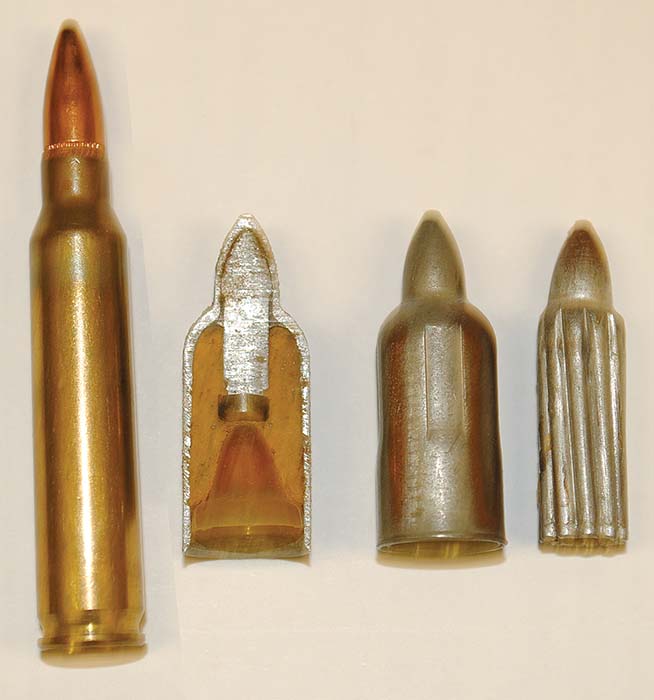
Cartridge case headstamps are an interesting and complicated field, and we get many inquiries about these. New companies, including small operations, are continually appearing, often using their own headstamps. And there are many special headstamps used on contract ammunition, the meaning of which even the manufacturer may not know. Keeping track of all this is nigh impossible. Some are deliberately deceptive; for example China made .30 carbine ammunition which looks like Lake City production, complete with an L C 52 headstamp. Reloaders were puzzled when they discovered rounds with this headstamp using Berdan primers.
It would be nice, of course, if each manufacturer kept us up to date and saved samples of their products, but that is not very likely. I guess the bottom line is that if readers think they may have something of interest to the Lab, we would certainly be glad to hear from them.
Visiting the Lab
SAR: Who have been some of the more well-known visitors to the collection?
Woodin: We have had a full spectrum, from the infamous such as William Thoresen, the machine gun collector who was killed by his wife Louise who later wrote about it in the book, It Gave Everybody Something To Do, to famous inventors such as the U.S.’s Eugene Stoner and Australia’s Russell Robinson who designed the Salvo Squeezebore system. He ended up living close to the Lab so that he could have easy access to it, and also he and his wife liked the area.
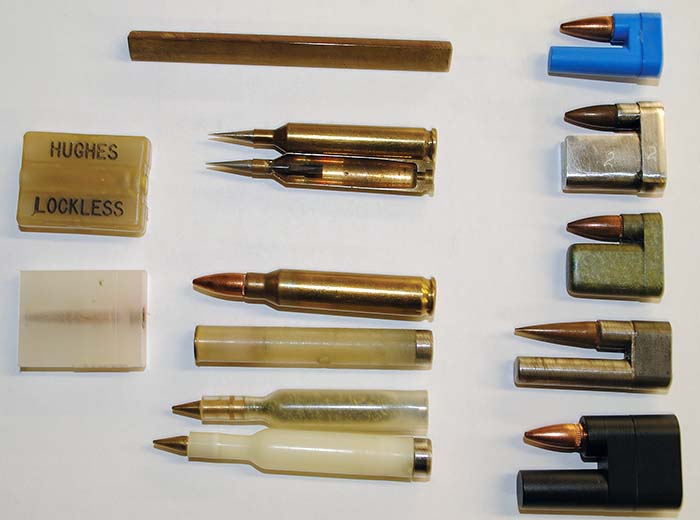
We have had collectors from just about every cartridge organization around the world. Ken Elks was here recently doing research for an upcoming book on Chinese ammunition, and before that for work on his Japanese ammunition books. Christian Koll from Linz, Austria, was here doing work for his book on Soviet cannons. Mel Carpenter spent some time here, researching ammunition for his forthcoming book on MBA Gyrojets and other products. Mel also brought a new cabinet in which he arranged our collection of Gyrojets. Peter Labbett, the expert on British ammunition, did research here. Jean Huon, the French ammunition author who has written for Small Arms Review, was here. The European association, ECRA, sent the person working on their database system to enter over 500 new case types over a two month period. Just recently the ECRA photographer was here to photograph all these new additions. And of course numerous criminalists have visited from forensic labs around the world.
SAR: By now some SAR readers are probably wondering how they could visit the Lab.
Woodin: It is not open to the general public and our time is limited, but members of cartridge organizations, AFTE members, law enforcement, serious researchers, writers and historians are generally welcome. We do not charge for queries, but have a good working relationship with the crime labs and others, who in turn are generous with supplying samples we need. And they are always on the lookout for items of possible interest.
(Author’s note: Pepper Burruss recommends visiting a cartridge show to get a taste of the hobby and science of cartridge collecting. Regional and local shows are held throughout the world. In the United States the most prominent gathering is the annual St. Louis International Cartridge Show (SLICS) generally held the days proceeding the Easter weekend. It is also an opportunity to meet Bill Woodin since he has never missed that gathering since its inception in the late 1960s.)
The Future
SAR: What are the long-term plans for the Lab?
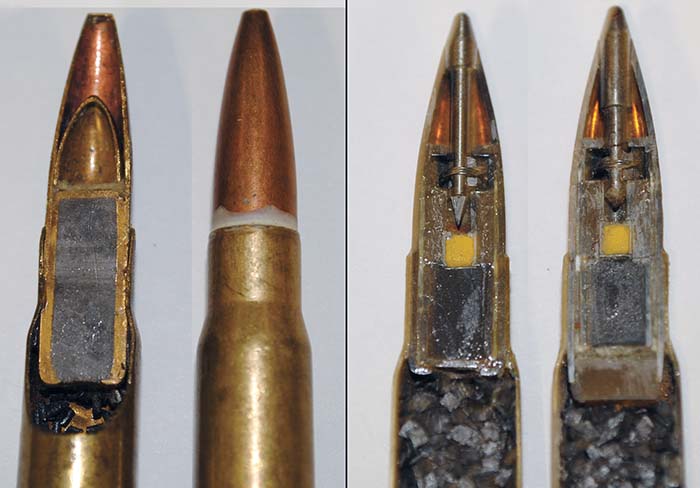
Woodin: This will be up to the Board ultimately. We of course want to remain where we are as long as possible. Our main concern is keeping the integrity of the collection whole and having it as an international reference point for future generations.
We believe that access to this collection and the unique information it contains is extremely important, far beyond its usefulness to cartridge collectors. This is not speculation: it is based on the nature of the inquiries that we receive from around the world. For example, the Lab has been used to identify enemy ammunition sources from a number of conflicts, including the two Iraqi wars and the war in Afghanistan. It has been useful in scores of other military and police forensic investigations around the world. The Lab is a serious research facility supporting criminal or military police investigations and cartridge designers around the world.
SAR: What does the Lab currently need?
Woodin: If you ask the Foundation’s treasurer (my wife), it would always be more funds. (Laughs)
We are always on the lookout for unusual military and police cartridges. What we try to obtain is the very first and last date for each loading and headstamp, plus any key milestones along the way if some change took place. We are very interested in experimental cartridges, whether or not they succeeded, and also literature in our field such as technical reports on military or police ammunition.
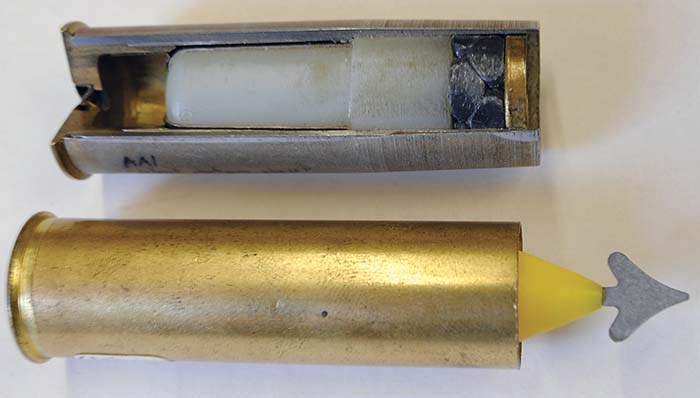
One non-cartridge item we do need for our Faxitron X-ray machine, in case anyone has some to spare, is Type 52 Polaroid film that is not too long out of date. By the way, the best images are taken using the neutron beam from a nuclear reactor; it slices through lead like butter, but the individual powder grains are clearly visible. This may be a bit of a budget stretch for the Lab, but it would be nice to have access to such a facility. (Laughs).
Advice to Readers
SAR: Most SAR subscribers shoot a lot of ammunition. Any parting advice for these readers?
Woodin: Absolutely! First, know the characteristics of the ammunition that you are feeding into your guns. Corrosive ammo is one obvious issue that can be dealt with, but ammunition identification is also important, for example knowing what the colors on military ammunition mean, which can be confusing. For example, black tip means AP on U.S. ammo, tracer on German, ranging (spotting) on 7.65 Mauser. Green primer seal indicates ball on German ammo, AP on British, incendiary on Japanese .303. And so on.
Second, know not just the shooting characteristics but the value of what you are shooting. Machine gun shooters typically have large inventories of ammunition, particularly military surplus ammo. It is unlikely, but not out of the question, that some of this might be rare and collectable, worth a lot more than just shooting value. For example, I once stopped a belt of .30-06 that was about to be fed into a machine gun – I think by J Curtis Earl – that had the rare EC 42 headstamp instead of the common EW. One of the best ways to understand exactly what you have is by networking within one of the cartridge organizations. The IAA Forum is also a very useful source of information.
Third, know the laws. Large-caliber projectiles, of course, must be inert – other than those registered under the amnesty. There are various state laws, such as those in California, prohibiting the possession of certain types of ammunition without a special license. At the national level, there are nearly two dozen so-called “proscribed” countries, such as China, Cuba, North Korea, Syria, Iran, Iraq, and samples of cartridges made in these countries cannot be brought into the U.S.; not helpful to the Lab research effort, as we receive many inquiries about cartridges made in these very countries.
SAR: Bill, thanks for your advice and the opportunity to visit the Lab and interview you for this article.
Woodin: You’re very welcome – thanks to Small Arms Review for your interest in the Lab.
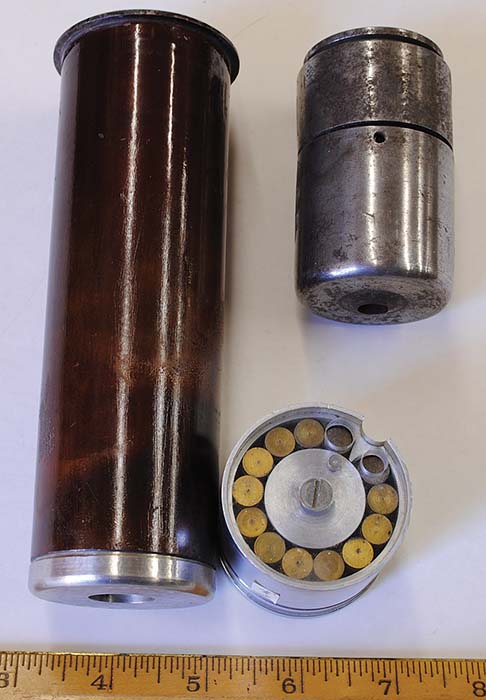
Contact Information
Woodin Laboratory can be contacted via e-mail at woodinlab@q.com. The International Ammunition Association (IAA) website, www.cartridgecollectors.org, also includes information about the St. Louis International Cartridge Show.
| This article first appeared in Small Arms Review V14N3 (December 2010) |



